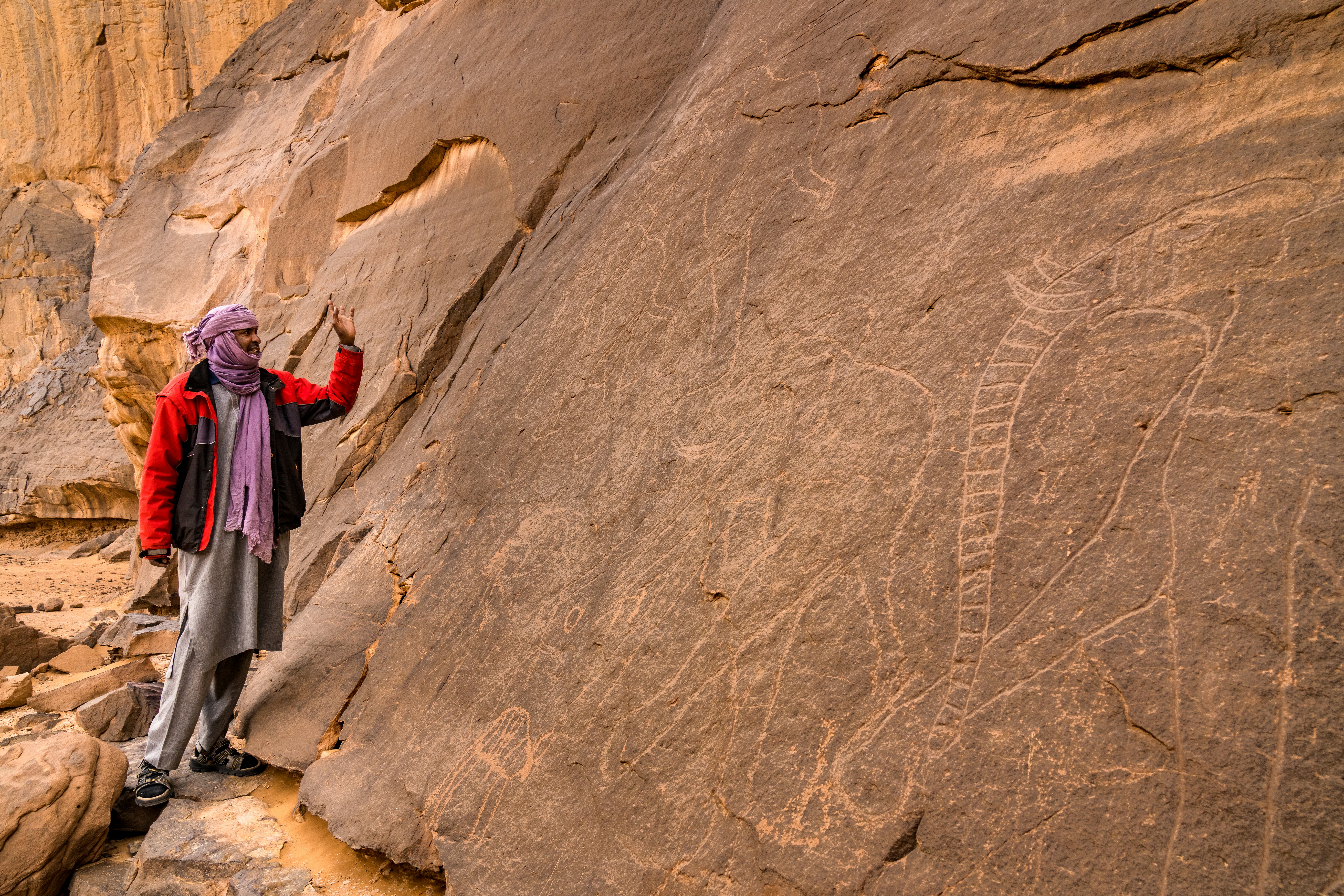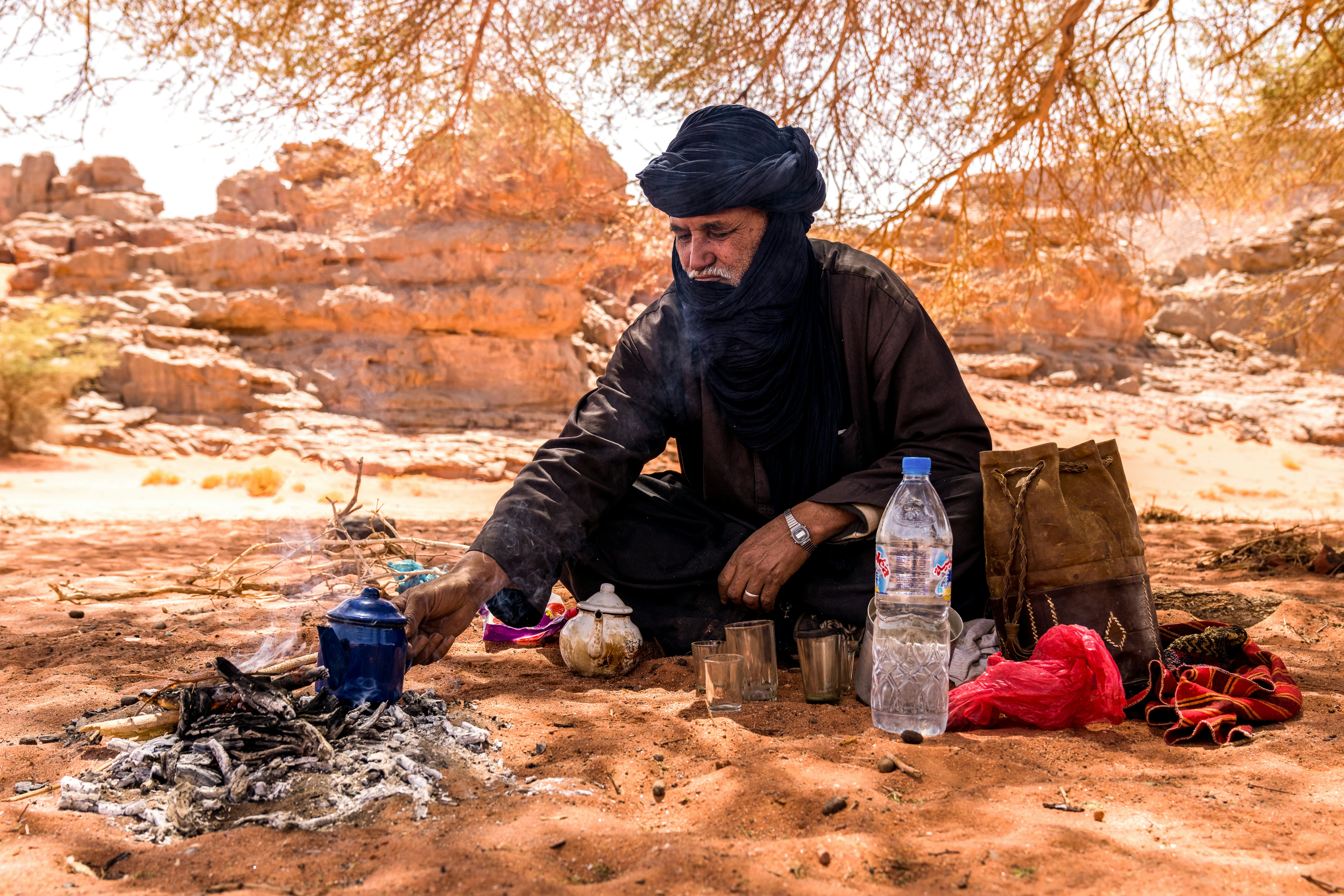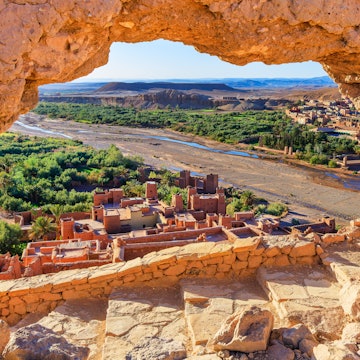
In Algeria’s Tassili N’Ajjer National Park, a land of rock forests and stone giants

Jul 19, 2022 • 13 min read

The author stands beneath a natural arch in the heart of the Tadrart Rouge region of Tassili N’Ajjer National Park © Marcus Westberg
On a visit to Algeria, writer Henry Wismayer and photographer Marcus Westberg venture into the country’s awe-inspiring (and seldom visited) interior.
In another gulch of geological marvels, at the end of an arcade of russet outcroppings, stands The Hedgehog. Its uppermost dome is a carapace of rumpled stone; its underside is scoured smooth by eons of wind and rain. Its weight is born improbably by three slender columns. A stubby snout is turned askance, as if sniffing the air. That a lump of rock could have been eroded into this shape by an accident of elemental forces seemed absurd. But then everything felt surreal after two days in Tassili N’Ajjer, where this kind of natural artistry was becoming routine.
If this is the first time you’ve encountered the name, you're probably not alone. Truth is, I’m not sure I would have found my way there at all if it wasn’t for a message I received from a fellow writer, recently returned from Algeria, who dodged my questions about its northern cities, historical sites and Mediterranean coast, and said: “You must go to Tassili.”

Located in the southeast corner of Algeria, Tassili N'Ajjer National Park covers 72,000 square kilometers of the Sahara Desert, which makes it slightly bigger than Ireland. Across this vast space, the desert erupts in a great jumble of sandstone pinnacles, tabular mountains and colossal dunes of polychromatic sand. Unesco, which inscribed the park as a World Heritage Site in 1982, describes its otherworldly landscapes as “rock forests”.
By the time photographer Marcus Westberg and I flew over the yellow wastes of the Algerian interior on the two-hour flight south from Algiers, Tassili had assumed the dimensions of a traveler’s grail. In my imagination, it seemed to promise something emancipatory and surreal: the coveted illusion of having a giant tract of the planet to ourselves.

We landed at Djanet, Algeria’s south-eastern outpost, on a hazy afternoon. Our guide, Abdesalam Ayoub, Salam for short, was waiting for us at the baggage carousel. Salam was willowy and convivial, and wore a magenta headscarf that marked him out as Tuareg, a member of southern Algeria’s dominant Berber tribe. We hopped into his friend Lahcen Abadi’s venerable Landcruiser and set off east along an empty asphalt road.
If Tassili was obscure, Salam admitted as we drove away from the airport, it was to some extent a conspiracy of geography and geopolitics. Geography, because our destination was extraordinarily remote, slap bang in the middle of the Sahara. Geopolitics, too, because we were close to Libya and Niger, two countries gripped by political dysfunction and Islamist insurgency. Algeria, fearful that instability, leaching across these once-porous nomad lands, might precipitate a repeat of its own terrible chapter of militancy in what Algerians call the ‘Black Decade’ of the 1990s, maintains an extensive military presence along the borders. We passed a large barracks within moments of hitting the road.
“There used to be camel trekking up there,” said Salam, gesturing to the Tamrit Plateau, a monumental escarpment, which is presently off-limits, as its inaccessibility hampers military patrols. “Now very few Western tourists come here, and nobody goes onto the plateau.”
Our destination was no less special, Salam assured us. We were heading further south, to a region of this sprawling wilderness which, though close to the Libyan border, is secure – a place known colloquially as the Tadrart Rouge.

Into the rock forests
By the second morning, after camping the first night on the periphery of the park, we had adopted the positions that would become customary over the course of our road trip: Salam, driver Lahcen and Zaoui the cook, shesh headscarves immovably wrapped around heads and necks, sat up-front; the Landcruiser’s trunk stuffed with food and camping gear to sustain us for six days and nights in the desert. And in between, Marcus and I, agog.
The thing that grabs you immediately is the topography, the astonishing scale and spectrum of vertical shapes. There are towering buttes springing from gravel plains, and cascades of brown rock that look like unsieved cocoa. Wide tracts of sand lead into amphitheaters of towering, striated rock. Numberless caves perforate the mesas.
The ridgelines, exposed to the full sculptural force of the wind, are a gallery of arches, columns and balconies. This endless variety of shape and silhouette means that the landscape quickly became a paradise for pareidolia, the tendency for the human brain to perceive recognizable images in random forms or patterns. A honeycombed scarp becomes the ruins of a desert ziggurat. Ridgetop pillars become high-browed heads, turned to one another in silent conclave. (One night we would sleep, in Salam's words, "behind the massive penis," a columnar rock whose figurative qualities were, I’m afraid, quite undeniable.)

A few miles past the military checkpoint known as “the door,” which marked the threshold of the Tadrart Rouge region, we pulled up beside what looked, at first glance, like a blank slab at the base of a cliff. Only as we got closer did we see the pictures: a herd of cows; a group of athletic hunters running after a swine-like quarry; a supine giraffe with intricately dappled hide. This was our introduction to what is one of the most significant concentrations of prehistoric rock art in the world.
The principal medium is oxidized sandstone, the same reddish pigment that stains many of the dunes, crushed and mixed with bonding agents like blood and cow milk. Some of the most elegant and enduring artworks are engraved, painstakingly etched onto boulders with a thousand strokes of a rounded stone. Between them, the pictures describe millennia of prehistory and chart the social evolutions that have been shaped by the region’s desiccating climate.

The oldest, some of which are thought to have been drawn 10,000 years ago, depict the megafauna we now associate with lands farther south – elephants, giraffes, lions – revealing that today’s desert was once fertile grassland. Later, Neolithic pastoralists settled the land, displacing the wildlife. They left behind elegant glyphs of the piebald cattle they reared on what remained of the savannah. The youngest drawings, disdained by Salam as “not old” (though many are older than the Roman ruins found elsewhere in Algeria) are abstract depictions of camels, symbols of the austere, semi-nomadic life that the Tuareg would inherit. Counter-intuitively, the refinement of the artistry deteriorates in this latter period. Whatever opportunity the early people had to linger in place and indulge artistic impulses had evaporated as desertification took hold. In the Sahara, ceaseless movement was a precondition of survival.
Wonders, revealed
After a day or so, I already had a feeling that we were in the grips of somewhere to rival the world’s great awe-scapes, those singular places – Antarctica, Patagonia, the Himalayas – where vast desolation resolves into a humbling form of beauty. But this was at least partly intuitive. We weren’t seeing the rocks in their best light. Throughout our second afternoon in the desert, sirocco winds from Morocco had filled the skies with orange dust. This had the effect of reducing visibility, but the haze also bled the rock of texture, depth, color and shadow. At Moula Naga, where we camped on the second evening beside a shaft of rock shaped like a camel’s head, you could look directly at the sun, a weak silver orb, half an hour before it hit the horizon.

The next morning, I awoke to urgent scuffling in Marcus’ tent, a sure-fire sign, for anyone who has traveled with a photographer before, that dawn conditions had improved. Within minutes, we had apologetically chivvied Lahcen from his morning fire, and rushed back to “The Cathedral”, a wide plain surrounded on two sides by rock towers with 50-foot-high apertures punched through the upper reaches. Yesterday, these godly windows had appeared flat and spectral. This morning, they stood in perfect relief against a deep blue sky.
“It’s a miracle!” declared Salam, when we returned. Given the views that were now materializing in every direction, this did not feel like an overstatement.
While the others broke camp, Salam led us on a walk south, across a valley basin. In places, the floor had a thick whitish crust, filigreed with hexagonal cracks. This crust showed the extent of the water’s reach during the summer rains when Tassili becomes a staging post for migrating birds. Colocynth, a desert herb with spherical gourd-like fruit, proliferated across the dried-up watercourses and Salam encouraged us to crunch the seed pods underfoot, liberating the contents as a kindness for the birds and gazelles.

The low dunes, meanwhile, were a transcript of the previous night’s activity. Beetle tracks scuttered in drunken crescents. Raven claws spun in circles. A jackal’s paw prints padded an unerring meridian across the sand. The whole tracery was crisscrossed by the tiny depressions of the jerboa, a weird chimerical rodent with outsized ears and kangaroo-like legs, which we often spied raiding our camp in search of crumbs.
It was a day of wonders. We saw enigmatic glyphs from a time before writing, and sandstone eroded into almost every conceivable shape and size. Rocks like mushrooms. Rocks formed into perfect parabolic archways. Rocks that looked like skyscrapers, or spacecraft, or preposterous two-ton hedgehogs.
In the evening, Marcus and I clambered onto the giant orange dune of Tin Merzouga. The spine was a perfect wind-sharpened arabesque, and we scurried along its edge, aprons of displaced sand avalanching beneath each footstep. From its 304-meter crest, we gained an extra-terrestrial overview of the lowlands we’d spent the day exploring. Serried ramparts stretched to the horizon, the colors deepening with the lowering sun. On the opposite side, looking northeast, terracotta dunes rippled into Libya, just 20 kilometers away.

In that moment, I understood the pull of the desert in a way I never have before. Everything was somehow both exquisitely still yet impermanent at once, the whole tableau rolling and eroding, grain by grain, fluxing on a scale too gradual for humans to perceive.
I had spent much of the day considering the human story narrated by the rock art, only to feel it now shrink to a pinprick in the face of the desert’s other chronology, the dizzying arc of geological time.
Where the desert means freedom
For the next three days, the pattern was established. In the mornings, we walked or drove to a particularly beautiful point in the park – usually the lee-side of a mesa – where the crew decamped for lunch, leaving Marcus and I free to wander into slot canyons, and onto flat-topped inselbergs, seeing how far we could go before the geology barred our way. These expeditions yielded broadening perspectives, but also ceaseless discoveries. In places, millennia-old shards of stippled pottery, together with fossils of simple plants and organisms were as easy to find as chewing gum on an urban pavement.

When we returned to camp, Zaoui would be waiting for us with thick coffee and aliwa, a green wheat soup. All three of the guides felt like fast friends. Versed in the nomadic spirit of hospitality and sharing, the Tuareg are natural hosts. Zaoui, whose face was stained gray from years of wearing an allichu, the traditional deep blue veil worn by Tuareg men, was even at pains to nourish the local fauna. When, at one lunch stop, a herd of camels approached to scrutinize us, he ambled up with a large bowl of water, which the boldest three drained within 20 seconds.
It was hard to resist the speculation that the Tuareg seemed grateful for the pretext to be here. Most evenings, while Marcus and I scrabbled about in search of high ground, the three men would unload the gear, light a fire, then congregate for a competitive game of boules.
The other two deferred to Lahcen, who was the eldest by some years. On our last evening, camping on the sand, in the wide-open, we found him in his habitual repose: legs crossed, supervising a pot of mint tea, which he always brewed with liturgical solemnity, only to adulterate the result with a great slew of sugar.

He had been born in 1950, he told us, in sing-song French, down near the Malian border. His early years were free and idyllic, spent moving from place to place by camel caravan. “He knows the desert from here to Mauritania,” interjected Salam admiringly.
In the turbulent final years of French colonial rule, as Algeria’s populous north became mired in a brutal war of independence in which between 400,000 to one million people died, the Tuareg, in Lahcen’s telling, existed in a tranquil parallel world. “There were no border posts then,” Lahcen recalled. “We went where we wanted.” Everything changed after Algeria secured independence in 1962. Borders ossified and bureaucratized as the young nation asserted its frontiers. Emancipation for the wider country ironically augured less freedom for the nomads.
Now, Lahcen admitted, tourism was a necessity, the obvious diversification for a nomadic culture anxious to maintain its spiritual affinity with the desert. Covid had been “catastrophique.” He feared it would only hasten the diaspora north, where many Tuareg now worked in the oil and gas fields. “Most of the young people don’t want to live the old life,” he said – the universal indigenous tragedy playing out in slow-motion.

That night, as the moonrise made way for a thick canopy of stars, Lahcen made Tuareg bread. He crafted a heavy disc of dough, then placed it in the fire, in a bowl of hot sand, raking the embers back over the top with a stick. Ten minutes later, the bread rose up through the ash, like a monster’s pate emerging from a tiny volcano. We ate the result, a dense, chewy loaf, combined with Zaoui’s lentil stew, which, like everything he conjured from his rudimentary kitchen, was delicious.
Paradise lost
It was late afternoon the next day when we lurched back onto the tarmac road. The purposeful locomotion felt uncanny after six days of fishtailing over grit and sand.

On the way back to Djanet, there was one last treasure for us to see. At an agglomeration of outcrops, a mile or so from the road, we stood and appraised a celebrated etching known as “the crying cows.” Hewn into the base of a rock tower, the etching pictured a huddle of long-horned cows, their bowed heads turned towards the viewer. Upon each face welled a single tear. Even by the standards of Tassili’s al fresco galleries, the workmanship was outstanding. Local myth holds that they were drawn by a cow-herd, who had traveled to this area in search of a spring only to find that it had run dry. The weeping cows were a projection of the artist’s own despair, as he watched his animals perish one by one.
How paradoxical, I thought, as we returned to the road. The very same land that betrayed the artist would, to a distant future generation of traveler, come to feel like a sanctuary from the world his descendants made. My phone signal pinged back to life. And like that, the notion passed, receding into the dunes.
Fancy Algeria can arrange a six-day tour of Tassili N’Ajjer, including domestic transfers from Algiers to Djanet, from around $700 per person.













